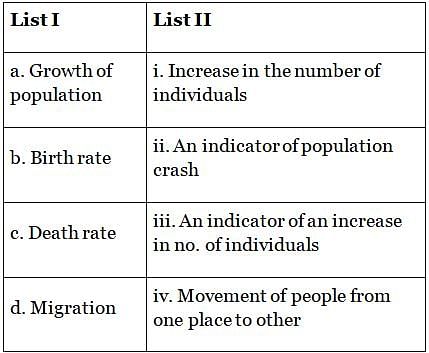KTET Paper 2: Social Science Test - 9 - KTET MCQ
30 Questions MCQ Test - KTET Paper 2: Social Science Test - 9
In which of the following places "Paramhans Mandali" was founded?
How many High Courts operate in the country?
| 1 Crore+ students have signed up on EduRev. Have you? Download the App |
Which of the following is not an aim of teaching Social Studies in schools?
To develop an appreciation of the interdependence of nations and regions of the world is one of the main objectives of teaching
Choose an appropriate and meaningful written assignment in Social Science from the following:
Where was the Hindustan Socialist Republican Association (HSRA) founded?
Which of the following is/are stated in the Constitution of India?
- The President shall not be a member of either House of Parliament.
- The Parliament shall consist of the President and two Houses.
Choose the correct answer from the codes given below.
Disciplinary approach to teaching social sciences focuses on:
A. The contents/subthemes of social sciences are also distinct from other disciplines.
B. Knowledge is a single entity and it cannot be divided into different disciplines.
The area of a rectangle is 'A' cm2 and length is cm. Its perimeter (in cm) is
Which of the following statements is true about endemic species?
The situation of depletion of ozone layer is referred to as ozone hole if the ozone level decreases below
What is the main source of energy for our planet Earth?
“Explain the concept of Forests” – this question helps us to know the achievement of which of the following objectives?
How many levels of Government are there in India?
The temperature in 'Visakhapatnam' is 40ºC. The temperature on Mt. Everest at the height of 8,848 metres will be
In Social Science, the recent NCF position paper on examination reforms emphasises
How can a social science teacher effectively and experientially transact the concept of sustainable development among students?
The most striking quality that a social science teacher needs to acquire is:
In India, the Munda Tribe lived in the region of
Most people during the 19th century felt education will have a corrupting influence on women.
Which of the following brings out the contextual meaning of 'corrupting' in the above sentence?
Projects in Social Science are useful
a. in theme based tasks
b. if they do not involve collection and analysis
c. if based on contexts from within the text
d. for the group work in class or at home
Which two alternatives from amongst the above given are correct?
Consider the followin gstatements and choose the correct answer.
Statement I: Latitudes are imaginary lines extended between the poles.
Statement II: Longitudes are parallel circles decreases in diameters from equator towards pole.
Which of the following is/are the merits of open book examination?
A. Students can use revision time more constructively, focusing on reinforcing their understanding of the subject rather than attempting to memorize information.
B. Open-book examination reduces the need to memorize information.
C. It can be suitable for all the subjects.
Consider the following Assertion (A) and Reasoning (R).
(A) Social science discipline is completely isolated from other disciplines and there is no relationship among different disciplines.
(R) The interdisciplinary approach to teaching is different in many ways from the traditional approach
Choose the correct option.
Which of the following are the largest and smallest continents of the world?
Four children of Class VIII were asked to create some creative articles from the waste material. On completion of the assignment, the teacher gave the following observations. On the basis of this information, adjudge the most creative child.
The three-dimensional aids used for the effective classroom instruction of social science do not include


















